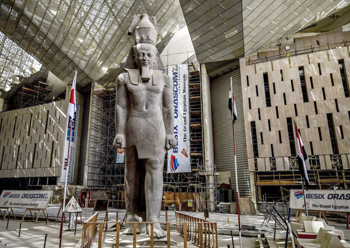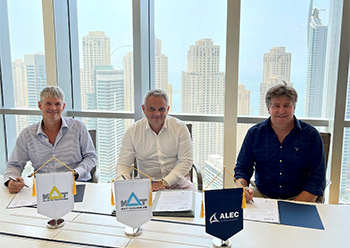
 Work on the Grand Egyptian Museum is nearing completion.
Work on the Grand Egyptian Museum is nearing completion.
Global infrastructure major Besix, in a joint venture with Orascom Construction, has achieved a key milestone with the transportation of the King Khufu Solar Boat, the oldest intact ship in the world, from the archaeological site of the Giza pyramids to the Grand Egyptian Museum.
The Besix-Orascom JV is in charge of the construction of the Grand Egyptian Museum, the world’s largest museum dedicated to a single civilisation and one of the largest constructions in Egypt since the pyramids. Work on the museum is nearing completion and the facility is expected to open later this year.
In addition to thousands of objects documenting the greatness of Egyptian civilisation, it will include the treasure of Tutankhamun, whose 5,300 objects will be displayed for the first time since their discovery in 1922.
The King Khufu Solar Boat is considered to be the oldest intact ship in the world. Presumably built for King Khufu’s afterlife, it was placed around 2500 BC in a pit at the foot of the Great Pyramid of Giza. Discovered in 1954 by the Egyptologist Kamal El Mallakh, the boat has been presented to the public since 1985 in the Giza Solar Boat Museum, a few metres from where it was found. Last month, the King Khufu Solar Boat was relocated from the Solar Boat Museum in Giza to a new dedicated building within the Grand Egyptian Museum complex.
 |
|
King Khufu Solar Boat ... being relocated to the museum in a extremely delicate transport operation. |
“This extremely delicate transport operation was carried out under the expert supervision of the Besix-Orascom Construction Joint Venture and with the support of their subcontractor Sarens, in perfect cooperation with the Egyptian authorities,” says a company spokesman.
Giving a timeline on the successful operation, he says the operation began on August 5 with the careful extraction of the King Khufu Solar Boat. Weighing 45 tonnes, with a length of 43.6 m and a width of 5.9 m, it was lifted and installed to the centimetre in a secure 60-tonne steel cage, made to measure for the operation.
This extraction was carried out by driving a self-propelled modular transporter (SPMT) into the building, in such a way as not to jeopardise the integrity of the ship, which required taking into account multiple parameters, including the relatively strong wind on the Giza plateau and very little room for manoeuvre due to the narrow structure of the existing building and the delicate archeological environment.
The transport itself started the next day. The convoy was fully remote-controlled and reached its destination at a speed of 1 km per hour. It left the pyramid area via a narrow ramp winding between the Giza monuments and then travelled a distance of 8.5 km before reaching its final destination. The route, which was much longer than the bird’s-eye distance between the pyramids and the Grand Egyptian Museum, was chosen due to stability of the roads used, the size of the convoy and the necessity to navigate safely through an area abounding with archeological heritage.
On August 7, the King Khufu Solar Boat was placed in its new dedicated building within the Grand Egyptian Museum complex. To do this, it was raised by 800-tonne crawler crane to a height of 30 m so that it could enter through the roof of the building and be installed with centimetre accuracy in the exact position where future visitors will be able to admire it.
Besix Deputy CEO Pierre Sironval says: “We are extremely proud of the achievement of this extraordinary and delicate operation and the excellence with which it was carried out. This will be a major museum jewel for the world to which we have just added a fantastic additional piece, the world’s oldest intact ship.”





















_0001.jpg)


.jpg)
















.jpg)








.jpg)





